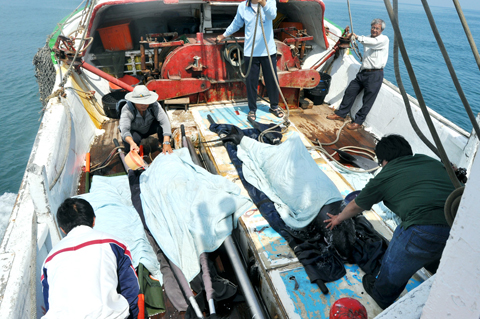Seventeen pygmy killer whales were returned safely to the ocean yesterday after becoming stranded on the beach near Hsinta Port (新達) in Kaohsiung County, the Forestry Bureau said.
The bureau said in a statement that it received a report at 11pm on Sunday that 21 whales were stranded on the beach near the port.
The bureau sent Wang Jiann-ping (王建平), director of Taijiang Cetacean Rescue Center (台江鯨豚救援中心), to direct the rescue operations.

PHOTO: SU FU-NAN, TAIPEI TIMES
Led by a speed boat from the Kaohsiung Fire Department, the 21 stranded pygmy killer whales attempted to swim back out to sea.
However, 15 of the whales were washed back to the beach again by large waves at around 3am yesterday, including four that had already died.
The remaining whales were then carried out to open waters by boats and released, the bureau said.
Wang said in an interview with the Central News Agency that a pod of pygmy killer whales generally has about 10 to 20 members, adding that they are most likely to be seen near the beaches of the southwest coast from October to March.
Wang also said that the sizes of the stranded whales varied from less than 1m to 2m.
He said that they probably belonged to the same pod, and it was unclear why they had become stranded.
According to the Forestry Bureau, pygmy killer whales mainly live in tropical seas.
They can be found in Honshu, Japan, Taiwan, the Philippines, Malaysia and Indonesia.
The bureau also said that the body length of a newborn pygmy killer whale is about 80cm, and can grow to 2.1m to 2.6m.
Pygmy killer whales weigh between 110kg and 170kg.
As research on the whales is scarce, the bureau said that scientists only know that they live mainly on fish and squid.
Last month, the Forestry Bureau released a wounded pygmy sperm whale, which was found stranded in Kaohsiung in January, back to sea. Scientists installed a tracking device on the whale to study the species.

SHIPS, TRAINS AND AUTOMOBILES: The ministry has announced changes to varied transportation industries taking effect soon, with a number of effects for passengers Beginning next month, the post office is canceling signature upon delivery and written inquiry services for international registered small packets in accordance with the new policy of the Universal Postal Union, the Ministry of Transportation and Communications said yesterday. The new policy does not apply to packets that are to be delivered to China, the ministry said. Senders of international registered small packets would receive a NT$10 rebate on postage if the packets are sent from Jan. 1 to March 31, it added. The ministry said that three other policies are also scheduled to take effect next month. International cruise ship operators

HORROR STORIES: One victim recounted not realizing they had been stabbed and seeing people bleeding, while another recalled breaking down in tears after fleeing A man on Friday died after he tried to fight the knife-wielding suspect who went on a stabbing spree near two of Taipei’s busiest metro stations, Taipei Mayor Chiang Wan-an (蔣萬安) said. The 57-year-old man, identified by his family name, Yu (余), encountered the suspect at Exit M7 of Taipei Main Station and immediately tried to stop him, but was fatally wounded and later died, Chiang said, calling the incident “heartbreaking.” Yu’s family would receive at least NT$5 million (US$158,584) in compensation through the Taipei Rapid Transit Corp’s (TRTC) insurance coverage, he said after convening an emergency security response meeting yesterday morning. National

PLANNED: The suspect visited the crime scene before the killings, seeking information on how to access the roof, and had extensively researched a 2014 stabbing incident The suspect in a stabbing attack that killed three people and injured 11 in Taipei on Friday had planned the assault and set fires at other locations earlier in the day, law enforcement officials said yesterday. National Police Agency (NPA) Director-General Chang Jung-hsin (張榮興) said the suspect, a 27-year-old man named Chang Wen (張文), began the attacks at 3:40pm, first setting off smoke bombs on a road, damaging cars and motorbikes. Earlier, Chang Wen set fire to a rental room where he was staying on Gongyuan Road in Zhongzheng District (中正), Chang Jung-hsin said. The suspect later threw smoke grenades near two exits

The Forestry and Nature Conservation Agency yesterday launched a gift box to market honey “certified by a Formosan black bear” in appreciation of a beekeeper’s amicable interaction with a honey-thieving bear. Beekeeper Chih Ming-chen (池明鎮) in January inspected his bee farm in Hualien County’s Jhuosi Township (卓溪) and found that more than 20 beehives had been destroyed and many hives were eaten, with bear droppings and paw prints near the destroyed hives, the agency said. Chih returned to the farm to move the remaining beehives away that evening when he encountered a Formosan black bear only 20m away, the agency said. The bear